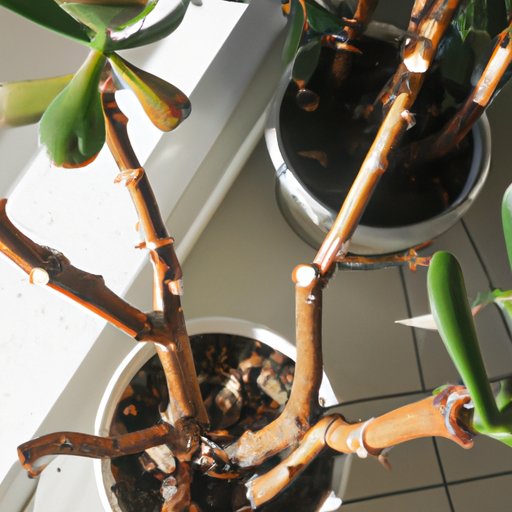
Introduction
Money trees have become a popular choice when it comes to indoor plants, thanks to their aesthetic appeal and supposed luck-bringing properties. However, it is not uncommon to find many of these plants dying, leaving their caretakers confused and frustrated. If you are one of those people wondering why your money tree is dying and what to do about it, then you’ve come to the right place. In this article, we will explore the symptoms of a dying money tree, common causes, preventative measures, and more advanced tips to keep your indoor plant healthy and thriving.
Understanding the Signs and Symptoms of a Dying Money Tree
Before we delve into the possible reasons for your money tree’s failure, it’s important that you know the specific signs and symptoms to look for. A healthy money tree usually has vibrant green leaves, a firm trunk, and healthy-looking roots. Any deviation from its original healthy appearance can signal an underlying problem. It’s common to see the leaves turning brown or yellow, falling off, or wilting. You may also observe that the trunk is gnarled, soft or that the roots are rotten. Once you notice any of these changes, it’s time to start troubleshooting.
Top 5 Reasons Your Money Tree is Dying and How to Fix It
There are various reasons why your money tree may be dying, but we’ve narrowed it down to the top five most common causes.
Overwatering
Money trees require measured watering. Overwatering can lead to root rot, which subsequently affects the other parts of the plant. The key to avoiding overwatering is to only water when the top inch of soil is dry. Also, make sure the container has proper drainage so that excess water can escape.
Underwatering
While overwatering can be disastrous, underwatering can also cause problems. The plant requires sufficient water to support its leaves and roots’ growth, and when it lacks this, the leaves may become dry and start to fall off. Hence, it’s crucial to ensure your plant is not dry for long periods of time. It needs to be watered at least once a week or whatever watering frequency correlates with your indoor environment.
Too much or too little light
Money trees need indirect light to thrive, and too much light can cause leaf scorching, while too little light can lead to stunted growth. Hence, it’s important to find an ideal place for your plant that gets enough indirect sunlight, but not the direct afternoon heat.
Poor soil quality
The quality of soil you plant your money tree into can severely impact its growth. The soil should be well-draining and part perlite-based. You can achieve this by mixing potting soil and perlite in a ratio of 2:1. If the soil is poor, it can cause root rot or stunt growth, leading to an overall sickly plant.
Insect infestation
Mites or scale insects can infest money trees, causing damage and poor plant health. Spotting this is easy: look for white, cottony tufts under the leaves or discoloration/wilting of leaves. If you detect any of these issues, it is essential to act quickly and use pesticides or insecticides designed to combat these pests.
Common Mistakes to Avoid when Caring for Your Money Tree
Mistakes can happen, particularly if you’re dealing with a plant species brand new to you, like the money tree. Knowing what to avoid and how to prevent these mistakes can be the key to a happy and thriving plant.
Choosing the Wrong Pot Size
The first mistake usually occurs when choosing the wrong pot size. Money trees need sufficient space to accommodate growth, and a pot that is too small can lead to root-binding. On the flip side, a pot that is too large can hold excess water, increasing the chances of root rot. Ensure you choose a pot one size up when your plant outgrows its present pot.
Over-reliance on Fertilizers
Fertilizers are an essential part of plant growth but using too much of them can harm your money tree. Over-fertilizing causes chemical buildup in the soil, which can lead to root burn. Most commercial fertilizers come with a set of instructions, and it’s crucial to follow them for best results. Only add fertilizers when necessary and in the advised amounts.
Ignoring Leaf-Fall
Many people forget the importance of leaf-fall. Leaf-fall is crucial in allowing your plant to conserve energy for the rest of its structure. Essentially, leaves are like food factories where photosynthesis occurs, and an unhealthy leaf structure can affect the rest of the plant. Hence, don’t be too anxious when some leaves drop off; it may be your plant’s way of conserving energy – provided it’s not too much leaf loss.
Troubleshooting Guide to Keep Your Money Tree Thriving
If you see that your money tree is not doing well, there are several steps you should take to troubleshoot and remedy the situation.
Diagnose the Problems
The first step to take is to figure out what caused your money tree’s decline, using the symptoms as a guide. This way, you can get to the root of the issue and prevent it from happening again in the future.
Carefully Evaluate Your Soil and Drainage
The soil and drainage are essential for your money tree’s thriving plant growth. You should inspect the plant carefully and assess the type of container being used. Make sure your plant has access to the right amount of draining water and that there’s no excess water in the container. By that, your money tree can breathe without the fear of soil-borne diseases such as root rot.
Adjust Your Routine
If you noticed an issue with watering, lighting, or humidity, it’s time to adjust your routine. Make sure to water only when the top inch of soil is dry, relocate the plant to a new location (if the previous one got too dark), or adjust humidity levels by misting the leaves and soil surface.
Expert Tips for Nursing Your Dying Money Tree Back to Life
If you’ve tried some of the standard methods for keeping your money tree alive and healthy, such as changing watering frequency, pot size or location, and you still can’t seem to make it healthy again, it’s time to take more advanced measures.
Provide Specific Fertilizers
One of the best ways to revive your dying money tree is using specific fertilizers designed for indoor plants. Some fertilizers help rejuvenate your plant and lead to noticeable, positive changes. In particular, fertilizers high in potassium and phosphate are ideal for plant growth.
Prune with Caution
If you have any brown leaves on the plant, snip the off with a sterilized tool. Angular or ragged cuts can lead to bacterial infections, which can further endanger your plant. Use rubbing alcohol to sterilize your tool before and after pruning.
Preventative Measures to Keep Your Money Tree Healthy
It’s always easier, cheaper, and less stressful to keep plants healthy before they get sick. Here are some general preventative measures you should take.
Watering
Consistently checking the top inch soil for moisture is the key here. Neglect can lead to underwatering or overwatering errors, leading to a sickly plant. Remember, the money tree’s tolerance for overwatering and underwatering is quite low.
Location
Money trees thrive in indirect lighting and excellent airflow. It’s helpful to place the plant in a warm area with good light exposure. A position near a door can work effectively by providing natural light.
Fertilizer
Use plant-specific fertilizers for a budget-friendly, healthy money tree. With indoor plants, it’s safer to go slow and steady than overfeed, as over-fertilizing can prove fatal.

Debunking Myths: Separating Facts from Fiction in Money Tree Care
The money tree comes with many myths and misconceptions attached to its care. Below, we will explore some of the most common and debunk them.
Discard the Pot and Move it to a Larger Space for Growth
You don’t need to transplant the money tree into a larger pot for growth right away. Give it time to adjust and grow on its terms before transplanting.
Water Through the Drainage Hole
You can water your plant through the top of soil or under a drainage hole, depending on what’s more comfortable for you at the time. However, we do advise pouring water through the top portion of soil to avoid water spilling out of the container.
Money Trees are Expert Survivors
Actually, if you neglect to water and care for your plant, it will likely suffer.
Conclusion:
The signs of a dying money tree are often easier to detect than to remedy, so it’s important to act quickly when you see symptoms. Address any issues with watering, lighting, or soil quality first, and then move on to advanced tips if necessary. Remember, the key to keeping your money tree healthy and happy is knowing what to do and being consistent in your care routine.





